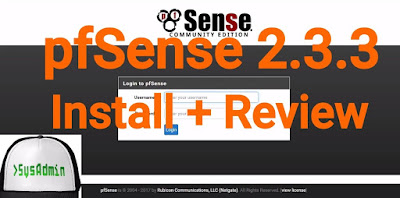 |
| pfSense 2.3.3 Firewall Installation and Review on VMware |
This tutorial shows pfSense 2.3.3 Firewall Installation, Configuration and Review on VMware Workstation/Player step by step. We also install VMware Tools (Open VM Tools) on pfSense Firewall for better VM performance and usability. This tutorial is also helpful to installing pfSense 2.3.3 on physical computer or bare-metal server hardware.
pfSense 2.3.3 Installation Steps:
- Download pfSense 2.3.3 ISO
- Create Virtual Machine on VMware Workstation/Player
- Start pfSense Installation
- pfSense 2.3.3 Initial Configuration via Web GUI
- Install VMware Tools (Open VM Tools) on pfSense
- pfSense 2.3.3 Review
Install, Configure and Review pfSense 2.3.3 on VMware
What is pfSense Open Source Firewall?
pfSense is a free, open source customized distribution of FreeBSD specifically tailored for use as a firewall and router that is entirely managed via web interface. In addition to being a routing platform, pfSense includes a long list of related features and a package system which allows further expandability. pfSense is installed on a physical computer or a virtual machine to make a dedicated firewall/router for a network and has been noted for its reliability and offering a range of features. It can be configured and upgraded through a web-based interface, and requires no knowledge of the underlying FreeBSD system to manage. pfSense is commonly deployed as a perimeter firewall, router, wireless access point, DHCP server, DNS server, and as a VPN endpoint. pfSense supports installation of third-party packages like Snort or Squid through its Package Manager.pfSense Website: https://pfsense.org/
pfSense 2.3.3 New Features and Improvements
pfSense 2.3.3 is a maintenance release in the 2.3.x series, bringing numerous stability and bug fixes, fixes for a handful of security issues in the GUI, and a handful of new features. As always, you can upgrade from any prior version directly to 2.3.3.pfSense 2.3.3 Minimum System Requirements
pfSense 2.3.3 has low minimum system requirements (for example 256 MB RAM and 500 MHz CPU) and can be installed on hardware with x86-64 architecture It is also available for embedded system hardware using Compact Flash or SD cards. pfSense also supports virtualized installation.Hope you found this pfSense 2.3.3 firewall installation, configuration and review tutorial helpful and informative. Please consider sharing it. Your feedback and questions are welcome!



I really like your blog with respective content, Thanks for sharing for your information about Devops Online Training Bangalore
ReplyDelete